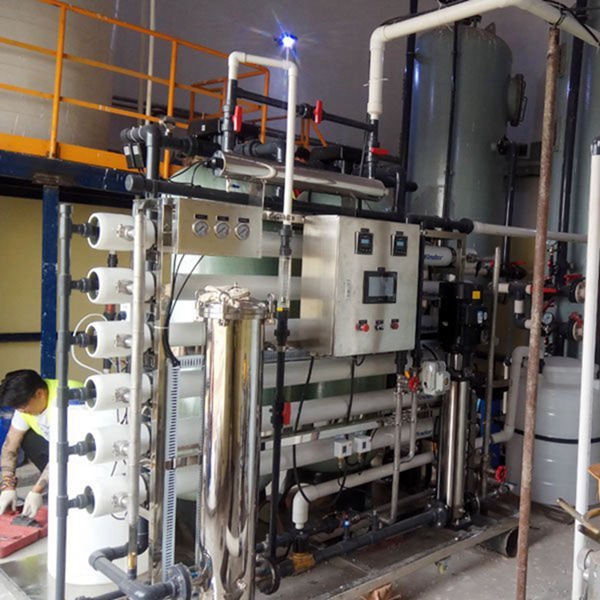The reverse osmosis membrane is the core component of reverse osmosis machine. The performance of the reverse osmosis membrane directly determines the quality of the effluent from the reverse osmosis machine. In general, the main indicators for measuring the performance of reverse osmosis membranes are four indicators: recovery rate, water production and flux, water conductivity or resistivity, and salt rejection. The following technical indicators are often used to evaluate a reverse osmosis machine.
1. Salt rejection rate and salt penetration rate
Desalination rate: The percentage of soluble impurity concentration removed from the system feed water by a reverse osmosis membrane.
Desalination rate = (1 - salt content of water production / salt content of influent water) × 100%
The salt rejection of the membrane element has been determined at the time of its manufacture. The degree of salt rejection depends on the density of the ultra-thin desalination layer on the surface of the membrane element, and the denser the desalination layer, the higher the salt rejection rate, and the lower the water production. The desalination rate of different substances by reverse osmosis is mainly determined by the structure and molecular weight of the substance. The desalination rate of high-valent ions and complex monovalent ions can exceed 99%, and the desalination rate of monovalent ions such as sodium ion, potassium ion and chloride ion is slightly lower, but it is also over 98%; the desalination rate of organic matter with molecular weight greater than 100 can also reach 98%, but the desalination rate of organic matter with molecular weight less than 100 is lower.
2. Recovery rate
Recovery rate: refers to the percentage of feed water to pure water in the RO membrane system. The recovery rate of the RO membrane system is determined at the time of design and is based on the preset influent water quality. The concentrated water valve installed on the concentrated water pipeline can be adjusted and set the recovery rate. The recovery rate is often expected to be maximized in order to obtain the maximum amount of water produced, However, the limit value of the membrane system should be that it will not precipitate and supersaturation of impurities such as salts.
Factors affecting recovery rate: pure water quality, concentrated water osmotic pressure, concentration of easily fouling substances, pollutant membrane substances, etc.
Recovery rate = (product water flow / influent flow ) × 100%

3. Water production (water flux)
Water production is an indicator of how much pure water is produced per unit time under a certain pressure condition of the reverse osmosis membrane. The measurement unit is usually GPD (gallon per day) and LPH (liter per hour).
Water flux refers to the product water flow rate per unit area of the membrane. It is an important indicator for the design and operation. It depends on membrane and the nature of raw water, working pressure and temperature.
Permeate flow rate: The permeate flow rate is also an important indicator of the amount of water produced by the reverse osmosis membrane element. It refers to the flow rate of permeate over a unit membrane area, and it usually expressed in gallons per square foot per day (GFD). Excessive permeate flow rates will result in faster water flow rates perpendicular to the membrane surface, exacerbating membrane fouling.
4. Water conductivity or resistivity
Conductivity: It indicates the total amount of soluble salts in the water. The dissolved salts in the water are all in the ionic state and they all have a certain conductivity. The higher the conductivity, the higher the dissolved salt content of water, and vice versa. The unit means: Siemens / meter, s / cm, and us / cm. Resistivity is the reciprocal of conductivity. These two indicators are often used to determine key indicators of pure water quality.
The conductivity of reverse osmosis machine is generally affected by the following factors:
1. Raw water: The quality of raw water has changed, and the raw water conductivity become higher so that it naturally affect the conductivity of pure water;
2. Pretreatment: mechanical filter , sand filter and activated carbon filter are not rinse regularly and timely;
3. The reverse osmosis membrane is damaged or exceeds the service period;
4. The security filter of the reverse osmosis plant is dirty and blocked;
5. When the RO desalination rate decreases, the water production drops by 10% or the RO inlet pressure rises by 10%, please check if RO membrane clean timely or not;
6. It is not operated and maintained in strict accordance with the requirements of the reverse osmosis machine manufacturer.
I believe that you have mastered the meaning of the above four indicators, and can better operate the reverse osmosis machine to achieve the purpose of use. If you encounter any problems during use, please consult Ocpuritech.

